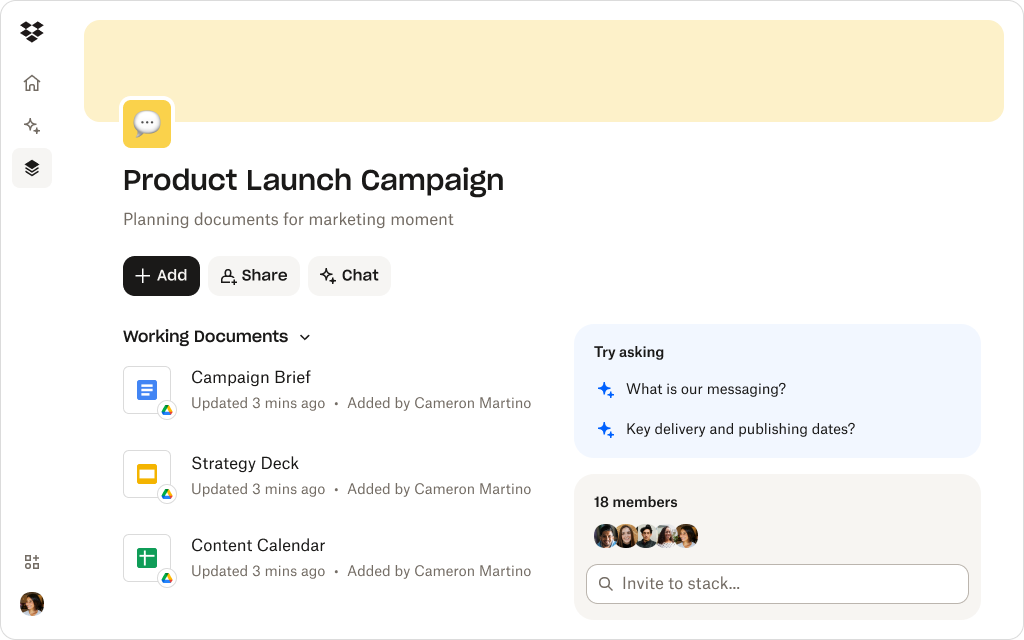
How marketing teams can use AI to filter incoming asks—while staying strategic.
Ad-hoc requests can derail even the best-planned marketing roadmap. A single "quick favor" turns into a design sprint. A minor landing-page edit snowballs into a campaign delay. Before long, your team is reacting instead of leading.
AI can help you get ahead of that chaos. By triaging incoming requests intelligently, you can separate what’s urgent from what’s merely loud—protecting your team’s time for high-impact work.
AI triage isn’t just about saying "no" faster—it’s about keeping your team focused on the work that moves strategy forward.
Here’s how to use AI to filter, score, and manage ad-hoc marketing requests—so you can move faster without losing focus.
Why ad hoc requests derail your marketing strategy
Marketing teams often live in “react mode.” One minute you’re executing a campaign, the next minute you’re pulled into a new ask—frequently from well-meaning stakeholders—about a landing page update, ad creative tweak, or collateral.
Over time, this constant context-switching:
- Slows down campaign velocity
- Erodes strategic focus
- Creates confusion over priority and scope
- Enables work to “leak” outside planned roadmap
Without a clear triage system, your team ends up prioritizing whoever shouts loudest instead of what drives the most value. That’s where AI can help—by filtering the noise before it reaches your to-do list.
When every request feels urgent, AI helps you step back and prioritize what’s actually important—so strategy stays intact, even when schedules get messy.

How AI can help you triage smarter
AI can act as your team’s first line of defense against chaos. Instead of manually sorting through every request, you can use AI tools to pre-analyze and score them based on factors like urgency, impact, and effort.
For example, when new campaign or creative requests come in, AI can:
- Categorize each request by type (creative, technical, messaging, etc.)
- Score them against your key priorities—like brand impact or ROI potential
- Flag duplicates or low-value asks for review
- Summarize long, unstructured requests into quick briefs for easier decision-making
The result: fewer interruptions, faster triage, and more focus on high-impact work.
But before AI can help, your team needs a shared definition of what “important” really means. That’s where a prioritization framework comes in.
What is a prioritization framework?
A prioritization framework is a structured method for deciding which tasks or requests deserve your team’s attention first. Instead of reacting to every incoming ask, it gives you a consistent way to assess each one based on effort, impact, and alignment with your goals.
Think of it as a scoring system for focus. For example, you might rate new requests by how much they contribute to key marketing objectives, how many people they reach, and how much time or budget they require. High-impact, low-effort tasks move to the top of the list—while low-impact, time-consuming ones get deferred or dropped altogether.
It helps answer questions like:
- What deserves our attention today?
- What can wait for later?
- What’s better left out altogether?
A strong framework keeps priorities clear by:
- Connect work directly to business goals like growth, retention, or brand visibility
- Balance value against effort so high-effort, low-return work doesn’t dominate your schedule
- Consider dependencies and confidence levels before committing resources
- Make trade-offs transparent so everyone understands why a decision was made
There are many prioritization models—from simple “impact vs. effort” grids to structured systems like RICE (Reach, Impact, Confidence, Effort)—but the key isn’t which one you choose, it’s applying it consistently.
When everyone uses the same method, decisions become faster, alignment improves, and your team feels more in control of its workload—not just buried under it.
Combining AI and human judgment: A hybrid model
Once your team agrees on a prioritization framework, the next challenge is applying it consistently. That’s where AI can help—by handling the volume of incoming requests while your team focuses on strategy and nuance.
AI can quickly analyze requests, identify patterns, and score them against your criteria for impact, effort, or alignment. But human judgment remains critical—AI can sort and suggest, not decide. The most effective approach is a hybrid model that blends automation with strategic oversight.
Here’s how to make it work:
- Use AI for first-pass sorting: Let it group or score incoming requests based on your chosen framework
- Keep humans in control: Review AI rankings to account for context or evolving priorities
- Allow overrides: Strategic opportunities sometimes outweigh scoring logic—humans should always have the final call
- Train the model with feedback: Mark each decision (“approve,” “defer,” “reject”) to help AI learn your team’s patterns over time
- Revisit criteria regularly: A “high-priority” task this quarter might not carry the same weight next quarter
This hybrid model gives you the efficiency of automation and the discernment of human expertise—helping your team respond faster without losing sight of what really matters.
The goal isn’t to replace judgment—it’s to make smarter decisions, faster, using AI as a teammate that understands your work.

Dash in action: Triage workflows with context
Once you’ve defined how you’ll evaluate requests, Dropbox Dash helps you put that process into motion.
It connects your team’s prioritization framework with real project data—so decisions aren’t made in isolation, but in context.
Here’s how Dash supports an AI-augmented prioritization workflow:
- Unified view of all active projects: Dash universal search shows all active campaigns, assets, and deliverables. When a new request arrives, you can instantly see what’s already in progress before adding more to the queue.
- Stacks (grouping): Group requests into themed Stacks —like “Urgent fixes,” “Brand initiatives,” or “Experiments.” Each Stack holds the files, briefs, and updates tied to those priorities.
- AI-powered Chat: Paste new requests into Dash Chat to summarize the details, compare them against your prioritization criteria, and generate a quick ranking or recommendation.
- Context linking: Connect every request to related decks, specs, or creative files stored in Dropbox. That way, reviewers have the full picture before approving or deferring work.
- Notifications and handoffs: Notifications in Slack, email, or Teams keep everyone informed as priorities shift, while Dash automatically surfaces the most recent changes and comments.
With Dash, triage moves from a manual task to a connected system—helping your team filter ad hoc requests faster, stay aligned on priorities, and keep every project grounded in strategy.
Stay focused with AI-powered prioritization
Keep your marketing priorities on track with AI-powered triage in Dash.
Keep your priorities connected
Filtering requests is only half the battle. Staying focused means keeping every decision connected to your broader marketing goals.
Dropbox Dash helps you turn prioritization into progress by linking campaign files, conversations, and approvals in one place. When AI triages the incoming noise and your framework guides the response, your team can move faster—without losing sight of strategy.
Stay focused with Dropbox Dash—where every request finds its place, and every decision stays connected to your goals.
Frequently asked questions
Yes—especially when it has context. AI can quickly summarize requests, highlight key details, and apply your team’s framework to surface what truly matters. Dropbox Dash goes further by grounding those insights in your actual files, campaigns, and goals. That means faster decisions, fewer distractions, and more time for strategy.
Review it quarterly, ideally alongside your marketing roadmap. Priorities evolve—and your scoring criteria should evolve with them. Treat it as an alignment exercise, not a chore. Regular reviews keep your AI and your team focused on what matters most right now.
Start small. Pilot the process with one type of request—like content or design asks—so the team can see the benefits firsthand. Make it clear that AI isn’t replacing judgment; it’s helping you protect focus. With Dropbox Dash, that process stays transparent, so everyone understands how priorities are set.
It can, which is why the best approach is hybrid. AI handles the first pass—sorting, scoring, and flagging patterns—while humans bring the strategic perspective. Dash keeps both in sync by linking every AI suggestion to the real work behind it: files, campaigns, and people.

.svg)
